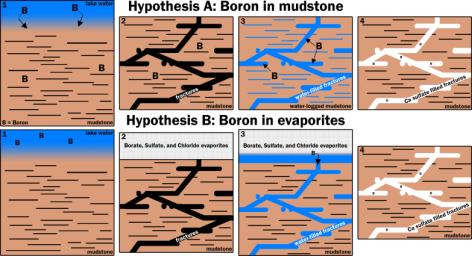This graphic portrays two hypotheses about how the element boron ended up in calcium sulfate veins found within mudstone layers of the Murray formation on Mars' lower Mount Sharp.
Hypothesis A is presented left-to-right in the upper four panels; hypothesis B in the lower four. Note that the two final panels are identical, depicting conditions found by NASA's Curiosity Mars rover. Calcium sulfate is the veins' main ingredient. The mudstone matrix around the veins resulted from deposition of sediments in a lake environment in Mars' Gale Crater billions of years ago.
In hypothesis A: (1) Boron dissolved in the lake and was incorporated into the lake bottom clays that became the Murray formation. (2) The lake then dried and the bedrock fractured. (3) Later groundwater interacted with the clays under conditions that released the boron into the groundwater. (4) Then, the boron was deposited along with the calcium sulfate that makes up the bulk of these veins.
In hypothesis B: (1) Boron was not incorporated into the clays as the lake was active. (2) Instead, when the lake dried out, it left a layer of boron-containing salts, and likely other types of salts, such as sodium chloride (table salt) and calcium sulfates, in an overlying layer that Curiosity has not yet visited. The bedrock fractured. (3) Groundwater later dissolved this layer of evaporite salts and moved the salts down into the older layers the rover has investigated. (4) The groundwater deposited the evaporite salts with the calcium sulfate that makes up the bulk of these veins.
Presented at the 2016 AGU Fall Meeting on Dec. 13. in San Francisco, CA.
NASA's Jet Propulsion Laboratory, a division of Caltech in Pasadena, California, manages the Mars Science Laboratory Project for NASA's Science Mission Directorate, Washington.
For more information about Curiosity, visit http://www.nasa.gov/msl and http://mars.jpl.nasa.gov/msl.

 Planetary Data System
Planetary Data System












